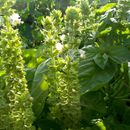Sweet Basil (
Ocimum basilicum) is unusual among the many culinary herbs in the mint family (Lamiaceae=Labiateae) in that it is thought to have its origins in India. This plant has been cultivated in India and the Middle East since ancient times and was known to the Greeks and Romans. In addition to its very familiar uses such as in tomato-based sauces and salads, it is an ingredient in the liqueur chartreuse. Sweet Basil is an erect annual, up to 35 cm in height, with ovate, toothed or entire, leaves which are up to 8 cm in length. The flowers are white or purple-tinged, around 1 cm long, and borne in simple terminal
racemes. Some varieties have partly red or entirely purple leaves. (Vaughan and Geissler 1997) A great diversity of Sweet Basil varieties have been developed (see
Simon et al.1999). Several aroma compounds can be found in different
chemotypes of basil, including
citral,
eugenol,
linalool,
methylchavicol, and
methyl cinnamate and are traded in the international essential oil market. These chemotypes are commonly known by names based on geographical origins such as Egyptian, French, European, or Reunion basil. The European type, a sweet basil, contains linalool and methylchavicol as the major constituents. The Egyptian basil is very similar to the European, but contains a higher percentage of methylchavicol. The Reunion type, from the Comoro Islands, and more recently from Madagascar, Thailand, and Vietnam, is characterized by high concentrations of methylchavicol. Methyl cinnamate-rich basil has been commercially produced in Bulgaria, India, Guatemala, and Pakistan. A basil from Java, Russia, and North Africa is rich in eugenol.
Simon et al. (1999) note that the diversity in basil based on appearance; flavors; fragrances; industrial, edible, and drying oils; and natural pigments provides great opportunities for developing new culinary, ornamental, and industrial crops. They also suggest that the high variation among basil cultivars in susceptibility to damage by
Japanese beetles suggests the presence of active ingredients that either could be useful in commercial traps or serve as a deterrent.
Simon et al. (1999) University of Vermont Extension provides links to a number of useful sources on Basil production.

